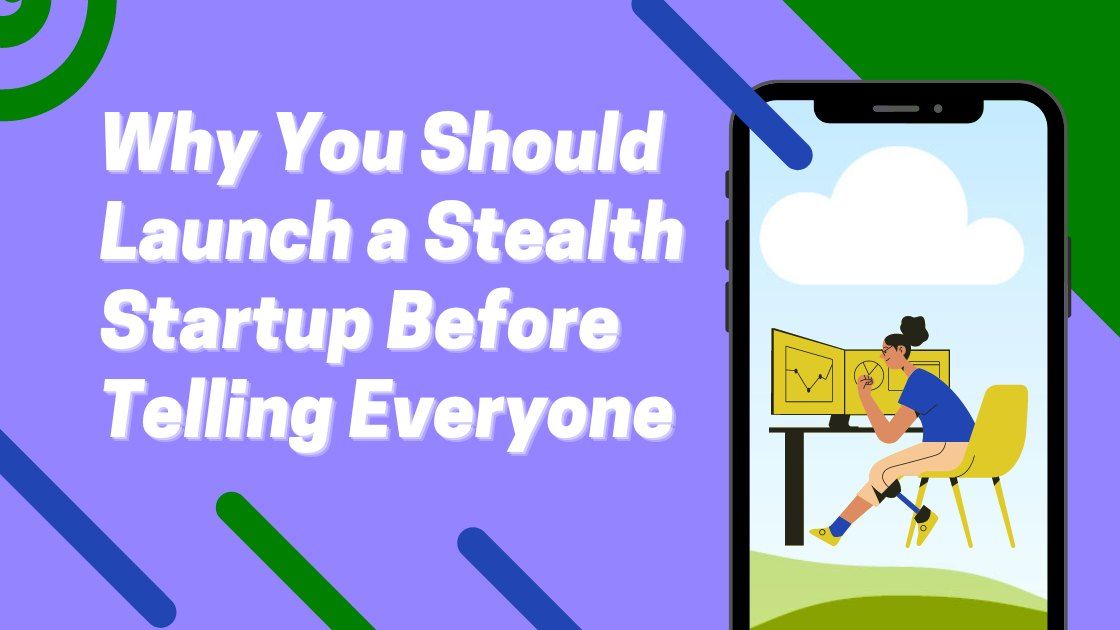Are you sitting on a million-dollar idea but not sure it's the "right time" to take the leap of faith away from your comfortable 9–5 job and dive into the deep end of starting your own business?
Well, it might never feel like the right time. Why? Because starting your own business is risky. Even with venture funding, 75% of startups fail.
But what if there was a way to have your cake and eat it too? In other words, build your startup in secret until you are ready to go full throttle and share it with the world.
That's where a stealth startup comes into play. You don't have to shout it from the rooftops when creating something new or innovating in an existing market. You can keep your business model under wraps until you're ready to share it with the world — and even then, you might decide not to tell anyone about your work.
Building a stealth startup has many benefits, from protecting your ideas to working at your own pace without worrying about making mistakes.
But building in stealth mode isn't perfect, either.
Keep reading to learn more about why launching a stealth startup is such an appealing option for entrepreneurs today, featuring some examples of companies that have had success launching in stealth mode.
What is a stealth startup?
A stealth startup is a company working on an idea but hasn't made it public yet.
In other words, a stealth startup doesn't have an online presence but looks like any other small business. It has employees working hard every day to ensure that the product launch goes off without a hitch (and maybe even some interns who are learning how everything works).
The difference is that while most small businesses choose to publish their website right away and start advertising their products immediately after creating a minimal viable product (MVP)—stealth startups keep tight lips.
The idea behind keeping it "on the down-low" is to build momentum before their competitors know what's up and launch with a bang when they're ready.
Stealth startups are increasing in popularity because of how much money they can raise from angel investors and venture capital firms. These groups love investing in new businesses, especially ones that aren't public and don't have any competition to worry about.
It's like an opportunity to start investing in something big before anyone else knows about it. For example, if you could have invested early in Apple or Tesla, today's payoff would be astronomical.
Try Markup Hero
Ready to make amazing graphics and annotated visuals?
Start using Markup Hero to take screenshots, annotate images and PDF's and take your stealth startup to the next level.
Signup For FreeBenefits of launching a stealth startup
Let's take a closer look at some benefits of running a startup in stealth mode.
Protect your ideas
The most obvious benefit of keeping your idea to yourself is that you can protect it. If you don't go public with your vision, no one will know about it, and there's nothing for the competition to steal or copy.
A stealth approach is popular among startups developing software like a report creator or an AI-powered tool. It protects founders' product development ideas while they build a business model, MVP, and launch strategy.
🏆 TRUTH: You may not think your ideas are worth protecting, but if someone steals them from you and turns them into a successful business, you could lose any chance of making money from that idea.
Take the infamous lawsuit between the Winklevoss twins and Mark Zuckerberg as the perfect example, where the twins claim Zuckerberg stole their idea for Facebook. And now, of course, Mark Zuckerberg is one of the wealthiest people in the world.
Some people might argue that they don't have time to build their startup in silence before telling everyone about it because they need a capital investment as quickly as possible.
However, this isn't true. Don't be afraid to bootstrap from the ground up. Even if you can only raise a small amount of seed money right now (or none), there are plenty of ways for startups without revenue models or proof-of-concept to succeed in stealth mode.
Avoid failing in public
It's hard enough for new businesses to succeed, but when you're just starting out, you don't want to be judged on every step of your journey. You want to fail privately and learn from your mistakes before you take them public.
In a traditional startup setting, if you make a mistake, people might see it and judge you for it. If the same mistake happens during a stealth build, no one sees it. You can fix minor issues before they grow into more significant problems.
If you want to protect yourself from public failure and any negative press, you should consider launching a stealth startup to keep your ideas from going into the public domain until they're ready for prime time.
Narrow in on your goals
Starting a business isn't a walk in the park. And most of the time, you are juggling multiple hats just to keep things afloat.
This may seem obvious, but too often, founders tend to think big and miss their target by shooting for something much larger than they're ready for. To succeed at building an MVP, you need to keep things simple.
Set ambitious goals without being unrealistic about what is possible within a reasonable timeframe. If you've identified an actual consumer point and built a solid customer base (even if it's just one), it's time to start thinking about expansion.
But don't rush into adding more features or changing your business model. Instead, try out some experiments that'll allow your team to get familiar with what works — and doesn't work — regarding scaling up your service before making any significant changes.
Work at your own pace
Another significant benefit of launching a stealth startup is working at your own pace. You can work on it whenever you want, whether in the middle of the night or first thing in the morning. You don't have to worry about deadlines, what other people think of your progress, or providing investors with updates.
And if you are still in the early stages and want to take on less risk, you can start as a side hustle while maintaining your current job. Then, once you are at a point where you are more confident in your product or service (i.e., if it's making money or has attracted investor attention), you can switch to full-time.
Control your digital footprint
When you take a stealth approach to your startup, the only thing out there's what you choose to share.
If someone wants more information about your company, they have to reach out directly instead of being bombarded with press releases or spammy content from other sources.
You can selectively share the right things at the right times without worrying about anything getting leaked accidentally.
Make a splash with an official launch
Even when launching a stealth startup, you need to officially register your business by choosing the proper structure for your business model and considering all business formation expenses.
But once you have crossed all of your t's and dotted your i's, you can launch your startup on your terms when you are proud of the product or service that you’ve created.
You can do certain things to maximize the visibility of your product or service at launch. The best time to launch is when it's relevant to a news cycle, or you have achieved a milestone in your business (like securing a new round of funding).
Of course, it doesn't have to be on that large scale. Spencer Haws, the creator of Link Whisper, aligned the drop of a new stealth startup (Originality AI) on Cyber Monday by offering a coupon code for 75% off to build buzz.
In short, when you have a successful thing going on, people take notice. Waiting until you reach that point helps you create your narrative and set the scene for how you want to be perceived by the public.
And don't be afraid to get creative with your launch and swing for the fences.

Downsides of building in stealth mode
Building a product in stealth mode can be a very effective way to get your idea out into the world without getting caught up in all the distractions that come with building a company under the public's microscope and answering to investors.
But it also comes with some drawbacks.
Lack of market feedback
When building a product, getting feedback from your target audience can be challenging if you're not talking about it openly. You might have a great idea, but if no one knows what you're doing, how'll customers learn to use it?
Some companies have a strong team of designers who can make decisions based on their research and knowledge of trends. Still, most startups don't have that luxury — and even if they do, it's important to get real-world feedback from people who aren't paid to think about your product daily.
If you're not getting the feedback and insights you need, it can be challenging to know when your product will be ready for the masses.
Less opportunity for buy-in
It can also be more challenging to get buy-in from customers and investors when you're in stealth mode — they don't know what you're working on, so they can't get excited about what might be coming down the line.
It's also important to remember that if you're trying to raise money from investors, they may not want to invest in something they haven't seen before or is in the pre-revenue stage. They could want additional proof that there's a market for whatever you're working on before they sign on the dotted line.
Examples of successful stealth startups
Despite some disadvantages, many successful companies began in stealth mode.
Here are three examples that'll show you how powerful it can be to launch a stealth startup:
1. Pacaso
A startup founded by former Zillow co-founder (Spencer Rascoff) and CEO (Austin Allison), Pacaso announced it raised $75 million in funding at a $1 billion valuation after less than a year on the market.
The company prides itself on simplifying co-ownership, where people can responsibly buy, own or sell a luxury second home. And they're one of the fastest US companies to receive unicorn valuations.
In September 2020, they left stealth mode with $17.7 million in seed round funding, and by March 2021, they hit unicorn status. What a magnificent trajectory.
2. Mist Systems
Bob Friday, the former Cisco CTO, left to start his business in 2014. But he ultimately kept quiet about what he was working on.
No one knew what he was up to until he opened up to the public two years later, announcing that they had received $144 million in venture capital to improve wireless networking with artificial intelligence and machine learning.
Then in 2019, Juniper Networks acquired Mist Systems for $405 million. Not bad for a five-year run!
3. Proprio Vision
In 2019, Proprio Vision emerged from stealth mode with $7 million in funding.
Proprio's proprietary platform uses light field technology with computer vision, data intelligence, and real-time anatomical alignment calculations to give surgeons a better understanding of their patient's anatomy and make informed decisions.
As of 2022, they've raised $42.1 million in funding, with $23 million stemming from a series A round led by DCVC. They also partner with some of the most well-known technology brands in the world, including Samsung, Intel, HTC, and NVIDIA.
Wrapping up
Launching a stealth startup has proven successful for many companies in the past. It can help protect you from competitors looking to steal your idea or take away clients from your business.
Not to mention that you can avoid distractions by narrowing in on one goal to develop a well-crafted product and working at your own pace without worrying about making mistakes along the way.
We hope you've learned everything you need to determine whether launching a stealth startup is the right decision for your business. While there are many benefits of building in public, many prefer not to have to deal with the pressures of the watching eyes.
At the end of the day, it comes down to what works best for you and your project.


